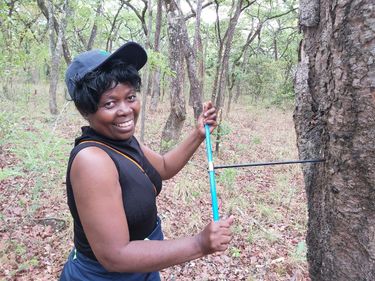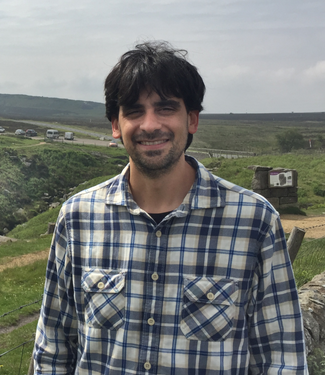
Sessions in which María Eugenia Ferrero participates
Tuesday 28 June, 2022
Half of the tributaries of the Amazon River originate in the tropical Andes; however, it is difficult to assess hydroclimatic conditions due to the scarcity of long, high-quality instrumental records. Data from the Global Precipitation Climatology Project (GPCP) provides a complete record since 1979 and offers a good representation of rainfall over the tropical Andes. Longer records are needed to improve our understanding of rainfall variability and summer monsoon behavior at various scale...
Thursday 30 June, 2022
Dendrochronological archives in the tropics of the Americas have been under-studied for a long time. Some of the challenges include the Identification of tree-ring boundaries in certain tree species, absence of winter dormancy associated to low temperatures in most of the cases, and logistic difficulties of fieldwork in remote sites. However, part of the slow progress is also related to the fact that historically much less resources have been inv...
Dendrochronological archives in the tropics of the Americas have been under-studied for a long time. Some of the challenges include the Identification of tree-ring boundaries in certain tree species, absence of winter dormancy associated to low temperatures in most of the cases, and logistic difficulties of fieldwork in remote sites. However, part of the slow progress is also related to the fact that historically much less resources have been inv...
The semi-arid Chaco is one of the most extensive forest formations in South America and has been subjected to high deforestation rates since the 1970s. At present, the main ecological, social and production problem in the region is the variation in water availability, a complex situation that combines a negative water balance and flood events. In this work, we studied the spatial and temporal variability of precipitation patterns, using rainfall instrumental records and tree rings of Schin...
Sessions in which María Eugenia Ferrero attends
Tuesday 28 June, 2022
Africa is faced with a number of challenges including climate change and ecological disturbance due to various anthropogenic activities. These problems adversely affect the forests and also ecosystem services. My appreciation for the forests motivated me to pursure my undergraduate studies in Forestry. I first applied dendrochronology during my PhD research which focused on understanding the climate change vulnerability of the Zambezi teak forests in Zambia. However, lack of research facil...
Historical accounts in the Brazilian Digital Library provide independent support for most of the tree-ring reconstructed wet season rainfall extremes in the eastern Amazon during the late-18th and 19th centuries. Newspapers, government reports, and other documents describe crop failure, livestock mortality, water shortages, and ship groundings on the Amazon River during many of the tree-ring reconstructed drought extremes. Heavy rains and flooding are described during some of the wet extre...
Regional teleconnections permit cross-continental modeling of hydroclimate throughout the world. Tree-rings are a good hydroclimatic proxy used to reconstruct drought and streamflow in regions that respond to common global forcings. We used a multi-species dataset of 32 tree-ring width chronologies from Chile and Uruguay as a climate proxy to infer annual streamflow (Q) variability in the Negro River basin, a grassland-dominated watershed of lowland Southeastern South America. A positive l...
Chemical traits of tree-rings are sparsely used for dendroclimatic analysis. The difficulty of the laboratory process to obtain these proxies and understand their physiological relationship with meteorological variables have limited the development of dendrochemistry in tropical forests. Here, we show the first Micro X-ray fluorescence (µXRF) time series of chemical elements from Cedrela fissilis trees growing in southern Brazilian Amazon. We assess the relationships among wood traits (wid...
Ring-width (RW) and Blue Intensity (BI) parameters (earlywood - EWB, inverted latewood – LWBinv, and delta - DB) were measured from samples of Araucaria araucana from six sites in northern Patagonia, Argentina. The distance between the most southerly and northerly sites is ca. 130 kms. Despite a much weaker between-tree signal for the BI parameters than RW, principal component analysis identifies a much stronger regional between-site signal for the BI parameters. Split period correlation r...
The ongoing North American megadrought has persisted since the year 2000, and has been characterized by anomalously low amounts of winter and summer precipitation. The climate systems providing these seasonal precipitation regimes are distinct in their origins but overlapping in their geographic ranges. However, our understanding is still incomplete in how alternation in water resources influences forest growth and physiology during extreme and persistent drought, including whether replete...
The current climate warming is unique in terms of its ubiquity and synchrony on a global scale. Over the last millennium, pre-industrial periods with warmer and colder temperatures occurred at different times in different locations around the globe (Neukom et al., 2019). Long-term temperature reconstructions in the Southern Hemisphere remain sparse and not always consistent among them (Lara et al., 2020). Therefore, to understand the temporal and spatial patterns of global-scale temperatur...
Wednesday 29 June, 2022
Information garnered from historical timbers and wooden artifacts (e.g. houses, barns, ships) can greatly enhance our understanding of human, ecological, and climate history, especially in regions where few old-growth forests and trees remain, tree longevity is relatively short (less than 300-400 years), and environmental conditions break down wood rather quickly, like in mesic to wet regions Over the last decade plus, the application of tree-ring techniques on woo...
Presentation of all Ameridendro2022 posters.FREE LUNCH FOR ALL ATTENDEES!
Recent studies have shown that long-lived tropical trees are able to recover from senescence stages and maintain high rates of aboveground carbon and biomass accumulation throughout their life span. In this study, we present a tree-ring-based analysis to estimate the annual accumulation of aboveground biomass (AGB) and carbon (C-accumulation) of an Ocotea porosa tree over the last five centuries (1485–2016). The study site is located in southern Brazil, under a subtropical climate. AGB was...
Hydroclimate variability in tropical South America is strongly regulated by the South American Summer Monsoon (SASM). However, past precipitation changes are poorly constrained due to limited observations and high-resolution paleoproxies. We found that summer precipitation and the El Niño-Southern Oscillation tarapacana (ENSO) in the Chilean variability and Bolivian are well registered Altiplano in in tree-ring the Central stable Andes oxygen (18–22°S, isotopes ∼4,500 (δ18OTR) m a.s.l.) of...
Water scarcity is a major 21st century challenge that is increasing the vulnerability of the human population, especially in cities. Water risk assessment is a fundamental task in many cities worldwide that often lack long-term and spatially-resolved records of precipitation and level of water reservoirs. Past rainfall and reservoirs levels may be alternatively assessed using tree-ring stable isotopes of urban trees. We assessed the past variability of precipitation and reservoirs level th...
Dendroclimatology in the tropical forest regions has lagged behind the more temperate forested regions of the world because of the challenge of determining annual ring formation. Despite over 230 tropical tree species known to form annual rings, the ITRDB shows few published chronologies in tropical forests in Sub-Saharan Africa. As part of the first “Training in Tree-Ring Science and its Applications” workshop conducted in Kitwe, Zambia, our team explored the dendroclimatic potential of B...
It has been shown that trees get older in the wet tropics, but the mechanisms behind this observation are still not clear. Literature shows that moisture could directly affect longevity by modulating physiological processes of trees. Other studies point to the potential role of water on tree size, which could indirectly affect longevity if one reconciles to the fact that the growth rate of tropical trees doesn’t differ significantly between wet and dry sites. The third group points to the ...
Oxygen isotope ratios in tree rings (δ18OTR) from Amazon forests have been shown to provide historical records of rainfall amounts at a large scale, due to the rainout of heavy isotopes during moisture transport. Here, we present a 110-year oxygen isotope record obtained from tree ring-cellulose of six Cedrela odorata trees (rbar = 0.57, EPS = 0.89) from the region of Tapajos River, Eastern Amazon. Our analysis indicates that δ18OTR series reflects inter-annual variability of wet season (J...
Stable carbon (δ13Cc) and oxygen (δ18Oc) isotopes in tree-ring cellulose, and tree-ring width (TRW), have been used extensively to investigate the effects of climate on tree growth. By contrast, the information recorded by the non-exchangeable carbon-bound hydrogen (δ2Hc) isotopes, has been far less explored. To create a comprehensive assessment of δ2H potential as a proxy for climate, hydrology, plant metabolism, and physiology we explored its relationships with climate an...
Rescheduled from June 28th to June 29th
Session reescheduled from June 28th to June 29th
Session reescheduled from June 28th to June 29th
Ring-width (RW) and Blue Intensity (BI) parameters (earlywood - EWB, inverted latewood – LWBinv, and delta - DB) were measured from samples of Araucaria araucana from six sites in northern Patagonia, Argentina. The distance between the most southerly and northerly sites is ca. 130 kms. Despite a much weaker between-tree signal for the BI parameters than RW, principal component analysis identifies a much stronger regional between-site signal for the BI parameters. Split period correlation r...
Chemical traits of tree-rings are sparsely used for dendroclimatic analysis. The difficulty of the laboratory process to obtain these proxies and understand their physiological relationship with meteorological variables have limited the development of dendrochemistry in tropical forests. Here, we show the first Micro X-ray fluorescence (µXRF) time series of chemical elements from Cedrela fissilis trees growing in southern Brazilian Amazon. We assess the relationships among wood traits (wid...
The ongoing North American megadrought has persisted since the year 2000, and has been characterized by anomalously low amounts of winter and summer precipitation. The climate systems providing these seasonal precipitation regimes are distinct in their origins but overlapping in their geographic ranges. However, our understanding is still incomplete in how alternation in water resources influences forest growth and physiology during extreme and persistent drought, including whether replete...
Thursday 30 June, 2022
How old are tropical trees? This fundamental question has long driven the curiosity of laymen and scientists. But only recently, a great number of studies conducted by many brave dendrochronologists resulted in a significant tree-ring-based knowledge that allows us to start accurately estimating tree ages across the globe. As science goes, not only knowing the longevity of tropical trees is essential to understanding forest dynamics and its role in biogeochemical cycles, but one must also ...
Under elevated CO2, photosynthetic carbon isotope discrimination is expected to increase in response to photosynthesis stimulation. While this response is widely documented in laboratory and field experiments, long-term proxies indicate that such response is not universally observed in response to the growth of atmospheric CO2. We investigated historical trends of photosynthetic carbon isotope discrimination derived from carbon isotope measurements of tree rings (Δ13C) from 147 chron...

